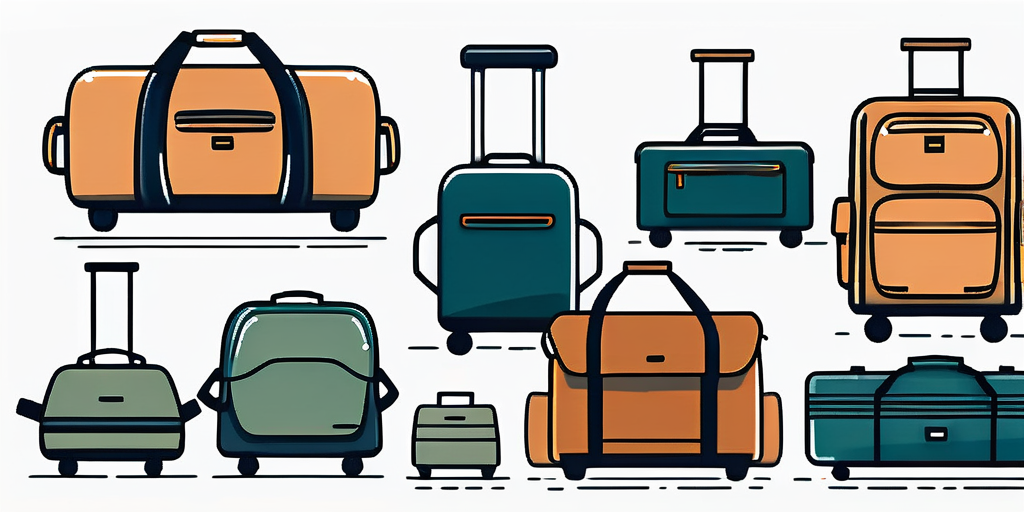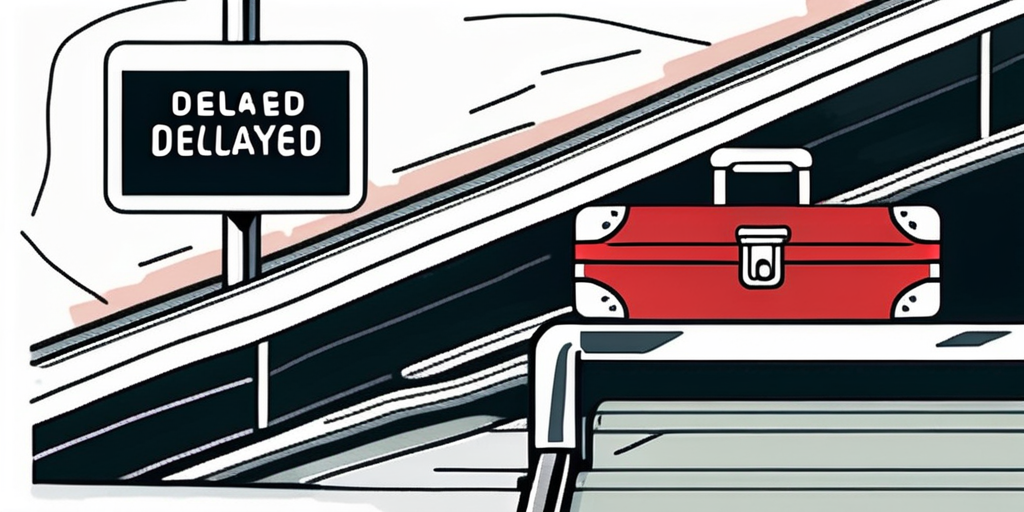The Ultimate Guide to Connecting Flight Baggage :
Learn how connecting flight baggage works. Understand the process and tips for smooth luggage transfers between flights for hassle-free travel.
In today's fast-paced world of travel, many people find themselves needing to take connecting flights to reach their final destinations. While connecting flights can offer convenience and flexibility, they also come with their fair share of challenges, especially when it comes to managing baggage. In this comprehensive guide, we will explore the ins and outs of connecting flight baggage, providing you with essential information and valuable tips to ensure a smooth journey from start to finish.
Understanding the Basics of Connecting Flight Baggage
Before we dive into the nitty-gritty details, let's first establish what exactly connecting flight baggage entails. Put simply, connecting flight baggage refers to the luggage that you check in or carry with you on a flight when you have to change planes at an intermediate airport. This is often necessary when your final destination cannot be reached by a direct flight.

What is Connecting Flight Baggage?
Connecting flight baggage refers to the bags that are transferred from one aircraft to another during a layover. These bags are typically checked in at the origin airport and retrieved at the final destination.
The Importance of Baggage Management in Connecting Flights
Proper baggage management is crucial when it comes to connecting flights. Inefficient handling of luggage can lead to delays, misplaced items, and unnecessary stress. By understanding the importance of effective baggage management, you can take steps to ensure a hassle-free journey.
Now, let's delve deeper into the intricacies of baggage management during connecting flights. When you have a layover, your baggage goes through a complex process to ensure it reaches the correct destination. Once you check in your luggage at the origin airport, it is tagged with a unique barcode that contains important information about your flight and destination. This barcode allows the airline staff to track your baggage throughout its journey.
At the intermediate airport, your bags are carefully transferred from the arriving aircraft to the connecting flight. This process involves a team of dedicated baggage handlers who meticulously sort and load the luggage onto the correct aircraft. They follow strict protocols to ensure that each bag is matched to the correct passenger and flight, minimizing the chances of any mix-ups.
During this transfer process, your bags may undergo security checks to comply with aviation regulations. These checks are performed to ensure the safety of all passengers and to prevent any prohibited items from being transported. Rest assured, the airline staff is well-trained to handle these procedures efficiently, ensuring that your bags are both secure and accounted for.
Once you arrive at your final destination, your bags are unloaded from the aircraft and transported to the baggage claim area. Here, you can retrieve your luggage by presenting the baggage claim tag that you received during check-in. It is important to double-check the tag to ensure it matches the information on your boarding pass, as this will help avoid any confusion or delays.
By understanding the intricacies of baggage management during connecting flights, you can appreciate the effort and attention to detail that goes into ensuring your luggage reaches your final destination. So, next time you embark on a journey with connecting flights, rest assured that your bags are in capable hands, and focus on enjoying your trip!
The Different Types of Baggage
Before we delve into the specifics of managing connecting flight baggage, let's take a moment to familiarize ourselves with the different types of baggage commonly encountered during air travel.
 When it comes to air travel, baggage plays a crucial role in ensuring a smooth journey. From carry-on luggage to checked baggage, each type serves a specific purpose and has its own set of rules and regulations.
When it comes to air travel, baggage plays a crucial role in ensuring a smooth journey. From carry-on luggage to checked baggage, each type serves a specific purpose and has its own set of rules and regulations.
Carry-On Luggage
Carry-on luggage refers to the bags that passengers are allowed to bring with them into the cabin of the aircraft. These bags are typically smaller in size and must comply with airline regulations regarding weight and dimensions. While carry-on bags may seem limited in space, they offer a convenient solution for storing essential items and personal belongings that you may need during the flight or layover.
From laptops and tablets to books and travel documents, carry-on luggage allows you to keep your most important possessions close at hand. Additionally, many airlines also allow passengers to bring a small personal item, such as a purse or a backpack, in addition to their carry-on bag.
Checked Baggage
Checked baggage, on the other hand, is the luggage that passengers hand over to the airline at the check-in counter. These bags are typically larger in size and are stored in the cargo hold of the aircraft. Unlike carry-on luggage, checked baggage is often more bulky and can include clothing, toiletries, and other non-essential items that you don't need immediate access to during the flight.
When it comes to checked baggage, it's important to pack wisely and efficiently. Many airlines have weight restrictions for checked bags, and exceeding these limits can result in additional fees. It's also crucial to ensure that your checked bag is securely locked and properly labeled with your contact information to avoid any potential mix-ups or loss during transit.
Now that we have a better understanding of the different types of baggage, we can explore the intricacies of managing connecting flight baggage. Whether you're a seasoned traveler or a first-time flyer, knowing how to navigate the complexities of connecting flights and handling your baggage can make your journey more enjoyable and stress-free.
Airline Policies for Connecting Flight Baggage
As with any aspect of air travel, different airlines have varying policies when it comes to connecting flight baggage. It is essential to familiarize yourself with these policies to avoid any surprises or complications while navigating through different airports.
Let's delve deeper into the world of airline policies for connecting flight baggage, shall we?
Domestic Flight Baggage Policies
When it comes to domestic flights, airlines often have specific rules and regulations regarding baggage allowances and fees. These policies may vary depending on factors such as the airline, cabin class, and frequent flyer status. It is essential to check with your specific airline to ensure you comply with their requirements.
For example, some airlines may have weight restrictions for carry-on baggage, while others may have size limitations. Additionally, certain airlines may charge extra fees for checked baggage, especially if you exceed their weight limits. It is crucial to familiarize yourself with these policies beforehand to avoid any unexpected fees or inconveniences.
International Flight Baggage Policies
International flight baggage policies can be more complex than domestic ones. Different countries may have their own regulations regarding the size, weight, and contents of luggage. It is crucial to research and adhere to both the airline's policies and the destination country's customs and immigration requirements.
When traveling internationally, it is essential to consider not only the airline's policies but also the customs regulations of the countries you will be visiting. For instance, some countries may have restrictions on bringing certain items, such as food, plants, or animal products. Failure to comply with these regulations can result in fines or even legal consequences.
Moreover, it is worth noting that some airlines have specific baggage allowances for international flights, which may differ from their domestic policies. These allowances may vary based on factors such as the destination, cabin class, or frequent flyer status. Therefore, it is crucial to check with your airline to ensure you are aware of any additional requirements or restrictions.
By being well-informed about the airline policies for connecting flight baggage, you can ensure a smoother and more hassle-free travel experience. Remember to check with your specific airline and destination country to avoid any surprises and make your journey as seamless as possible.
Tips for Managing Your Baggage During Connecting Flights
Now that we have a solid understanding of connecting flight baggage and airline policies, let's explore some practical tips to help you effectively manage your luggage during your journey.
Packing Smart for Your Journey
One of the most important aspects of managing your baggage during connecting flights is packing smart. It's essential to only pack the essentials and avoid unnecessary items that can add weight and bulk to your bags. Consider using packing cubes or compression bags to maximize space and keep items organized. Additionally, always pack valuable items and important documents in your carry-on luggage to ensure they stay with you throughout the journey.
Keeping Track of Your Baggage
While the responsibility of transferring your checked baggage from one flight to another ultimately lies with the airlines, it is crucial to keep track of your bags to minimize the risk of loss or delay. Make sure to attach clear and durable luggage tags with your contact information to your bags. Additionally, consider taking photographs of your bags and their contents in case you need to file a claim in the event of loss or damage.
Dealing with Lost or Delayed Baggage
Despite our best efforts, there may be instances when our baggage gets lost or delayed during a connecting flight. It's essential to know the steps to take in these situations to ensure a timely resolution.

Steps to Take When Your Baggage is Lost
If you find yourself in the unfortunate situation of having lost baggage, immediately notify airline personnel at the destination airport. Provide them with a detailed description of your bag and provide any necessary documentation, such as baggage claim tags. Most airlines have dedicated customer service departments that can assist you in tracking down and recovering your lost luggage.
How to Handle Delayed Baggage
If your baggage is delayed but not lost, the airline will usually provide you with a file reference number. This reference number can be used to track the progress of your bag. Airlines are typically responsible for delivering delayed bags to your designated address. In the meantime, it is advisable to keep a record of any expenses incurred due to the delay, as you may be eligible for reimbursement.
With the information and tips provided in this guide, you are now well-equipped to navigate the world of connecting flight baggage with ease. Remember to familiarize yourself with airline policies, pack efficiently, and always keep track of your bags. By doing so, you can ensure a stress-free and enjoyable journey to your final destination.
Get the Compensation You Deserve with ClaimCompass
If your travel plans have been disrupted by a delayed, cancelled, or overbooked flight, you might be entitled to up to 600€ in compensation. ClaimCompass specializes in defending air passenger rights in Europe, leveraging EU Regulation 261/2004 to determine your eligibility for a claim. Don't let the stress of managing connecting flight baggage be compounded by unclaimed compensation. Use our free compensation calculator to check your eligibility and let us handle the rest. With ClaimCompass, you have nothing to lose: if we can't secure your compensation, you owe us nothing. Submit a claim today and let us fight for the money the airline owes you.
